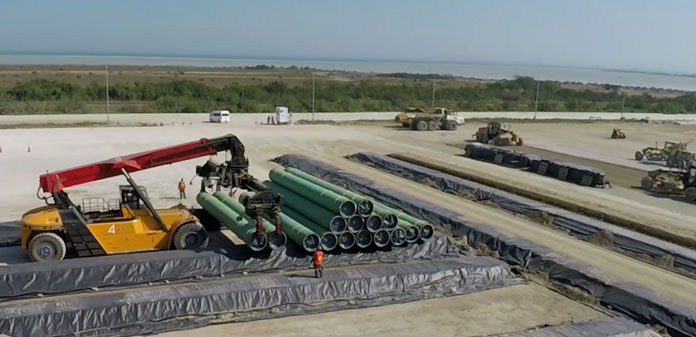Washington DC — Valley Crossing Pipeline asked the U.S. Federal Energy Regulatory Commission on Wednesday Jan. 30th for permission to put its Border Crossing natural gas facility into service in February, anticipating that the adjoining 2.6 Bcf/d Sur de Texas pipeline in Mexico will be completed by mid-February.
The filing represents the most affirmative statement yet regarding the timing of the massive new Sur de Texas pipeline, which will displace LNG imports and provide incremental supply to gas-starved markets across central and southern Mexico. S&P Global Platts Analytics expects the Sur de Texas pipeline will be the primary driver of growth of US exports to Mexico in 2019.
Combined with LNG, exports from South Texas hit an all-time high of nearly 4.2 Bcf/d in January, led by 3.8 Bcf/d of exports to Mexico and 0.3 Bcf/d of feedgas deliveries to Corpus Christi LNG. The pending startup of the Sur de Texas pipeline, along with the imminent commercial startup of Corpus Christi Train 1, suggest that South Texas exports will continue to ramp up strongly through the spring, potentially supporting basis across the Texas Gulf Coast.
Valley Crossing asked FERC for the signoff by February 8, pointing to mechanical completion of the Border Crossing facilities and adding that it has been notified that construction activities on the pipeline south of the border “are nearing completion and commissioning activities are anticipated to begin in mid-February 2019.”
TransCanada, Sur de Texas’ operator, could not immediately be reached for comment.
BORDER CROSSING
The 1,000-foot, 2.6 Bcf/d Border Crossing project will carry gas from the Agua Dulce hub in South Texas to an international border crossing offshore in the Gulf of Mexico near the port of Brownsville. From there, gas will be delivered to Mexico’s 2.6 Bcf/d Sur de Texas -Tuxpan pipeline, an offshore pipeline that will carry the gas south to connect with Mexico ‘s existing Sistrangas system first at Altamira and eventually at Tuxpan.
The Sur de Texas pipeline is expected to immediately displace LNG from the Altamira import terminal, which took an average of 370 MMcf/d last summer, peaking at nearly 600 MMcf/d in July.
In October, Valley Crossing received an extension from FERC on its in-service schedule, after the company noted it needed more time for completion of the third-party Sur de Texas pipeline. At that time, it pointed to “a different construction schedule” for the interconnecting pipe and unpredictable sea conditions in the Gulf of Mexico.
ABOUT ENBRIDGE
Enbridge is a North American leader in delivering energy. We exist to fuel people’s quality of life, and we have done so for nearly 70 years.
Enbridge operates the world’s longest crude oil and liquids transportation system. We’re also a North American leader in the transportation, processing and storage of natural gas.
Source: https://www.spglobal.com/

